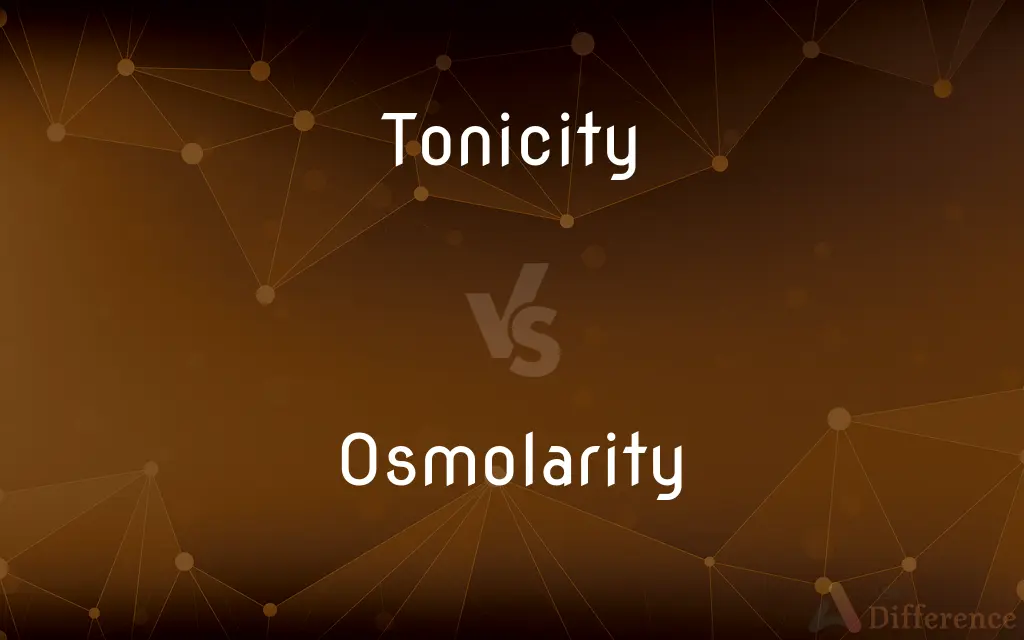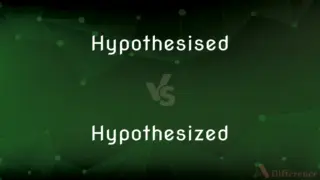Tonicity vs. Osmolarity — What's the Difference?
By Tayyaba Rehman — Updated on October 28, 2023
Tonicity refers to a solution's ability to cause a cell to gain or lose water, while Osmolarity is the concentration of solute particles in a solution.

Difference Between Tonicity and Osmolarity
Table of Contents
ADVERTISEMENT
Key Differences
Tonicity and Osmolarity are both essential concepts in understanding how solutions interact with cells. Tonicity focuses on the effect a solution has on cell volume, specifically if a cell will shrink, swell, or remain the same when placed in that solution. Osmolarity, on the other hand, strictly measures the concentration of solute particles in a solution, without necessarily indicating its effect on cells.
While Osmolarity gives a quantitative value of solute concentration, Tonicity provides a functional perspective of that solution's behavior with biological cells.
For instance, two solutions can have the same Osmolarity but different Tonicities due to the nature of the solutes and their permeability across the cell membrane. Thus, while Osmolarity is a purely quantitative measure, Tonicity ties this measure to its physiological relevance.
Comparison Chart
Definition
Effect of a solution on cell volume.
Concentration of solute particles in a solution.
Measurement
Based on solution's effect on cells.
Purely quantitative.
ADVERTISEMENT
Relation to Cells
Describes if cells shrink, swell, or remain unchanged.
Doesn't directly indicate effect on cells.
Dependent on
Nature and permeability of solutes.
Total number of solute particles.
Units
No specific units (hypotonic, isotonic, hypertonic).
Osmol/L or mOsm/L.
Compare with Definitions
Tonicity
A measure of the osmotic pressure gradient.
Tonicity determines the direction and extent of osmosis.
Osmolarity
The concentration of a solution expressed as the total number of solute particles per liter.
The Osmolarity of the solution was 2 Osmol/L.
Tonicity
The effect of a solution on the osmotic movement of water.
The Tonicity of the sugar solution caused the cell to shrink.
Osmolarity
A way to express the solute concentration in terms of osmotic pressure.
Osmolarity helps predict how a solution might behave when separated by a semipermeable membrane.
Tonicity
A descriptor of a solution's effect on cell volume.
Given its Tonicity, the solution made the cells swell.
Osmolarity
A quantitative measure of solute concentration.
High Osmolarity solutions have more dissolved particles.
Tonicity
The ability of a solution to cause a cell to shrink or swell.
The Tonicity of the saline solution caused the cell to remain unchanged.
Osmolarity
The total molarity of a solution when accounting for all solute particles.
The Osmolarity considers both the salt and sugar dissolved in the solution.
Tonicity
Refers to the relative concentration of solute in two solutions separated by a membrane.
Due to its Tonicity, water moved out of the cell.
Osmolarity
The total concentration of all solute particles in a solution.
The beverage's Osmolarity was increased by adding more sugar.
Tonicity
Tonicity is a measure of the effective osmotic pressure gradient; the water potential of two solutions separated by a semipermeable cell membrane. In other words, tonicity is the relative concentration of solutes dissolved in solution which determine the direction and extent of diffusion.
Osmolarity
(chemistry) The osmotic concentration of a solution, normally expressed as osmoles of solute per litre of solution.
Tonicity
Normal firmness or functional readiness in body tissues or organs.
Tonicity
The sustained partial contraction of resting or relaxed muscles.
Tonicity
(medicine) The normal presence of tone or tension in a muscle or organ; tonus
Tonicity
(sciences) The ability of nonpenetrable solutes in a solution to exert an osmotic pressure upon a membrane
Tonicity
The state of healthy tension or partial contraction of muscle fibers while at rest; tone; tonus.
Tonicity
The elastic tension of living muscles, arteries, etc. that facilitate response to stimuli;
The doctor tested my tonicity
Common Curiosities
What are the types of Tonicity?
Hypotonic, isotonic, and hypertonic.
Can two solutions with the same Osmolarity have different Tonicities?
Yes, because Tonicity also depends on the nature and permeability of the solutes.
What does Tonicity describe?
Tonicity describes the effect of a solution on the volume or pressure of cells.
Does a higher Osmolarity always mean a solution is hypertonic?
Not necessarily. It depends on the reference solution and the nature of solutes.
Can Osmolarity affect Tonicity?
Yes, but Osmolarity alone doesn't determine Tonicity since solute permeability is also a factor.
Is distilled water hypotonic or hypertonic?
Distilled water is hypotonic since it lacks solutes.
How is Osmolarity different from molarity?
Osmolarity considers all solute particles, while molarity counts only the concentration of a specific solute.
Why is Tonicity important in medicine?
Tonicity determines how cells will respond when exposed to a solution, which can impact medical treatments.
What happens to a cell in a hypertonic solution?
In a hypertonic solution, a cell loses water and may shrivel.
What's the significance of knowing a solution's Osmolarity?
Knowing Osmolarity helps predict how solvents, like water, will move across membranes.
How do Tonicity and Osmolarity relate to osmosis?
Osmolarity predicts the direction of solvent movement, while Tonicity describes the solution's effect on cell volume during osmosis.
Do cells prefer isotonic environments?
Yes, cells generally function best in isotonic conditions where they neither shrink nor swell.
How is Osmolarity measured?
Osmolarity is measured in terms of osmol per liter (Osmol/L) or milliosmol per liter (mOsm/L).
Why can't we use only Osmolarity to predict cell behavior?
Osmolarity doesn't account for solute permeability which influences cell behavior.
Are Tonicity and Osmolarity used interchangeably?
No, they refer to different properties of solutions, even though they are related.
Share Your Discovery

Previous Comparison
Hypothesised vs. Hypothesized
Next Comparison
Drip vs. TripAuthor Spotlight
Written by
Tayyaba RehmanTayyaba Rehman is a distinguished writer, currently serving as a primary contributor to askdifference.com. As a researcher in semantics and etymology, Tayyaba's passion for the complexity of languages and their distinctions has found a perfect home on the platform. Tayyaba delves into the intricacies of language, distinguishing between commonly confused words and phrases, thereby providing clarity for readers worldwide.















































